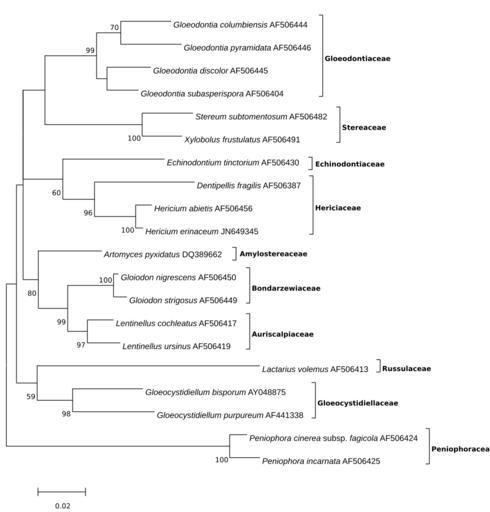MAKE A MEME
View Large Image

| View Original: | Gloeodontia-Maximum Likelihood-Tree.svg (129x134) | |||
| Download: | Original | Medium | Small | Thumb |
| Courtesy of: | commons.wikimedia.org | More Like This | ||
| Keywords: Gloeodontia-Maximum Likelihood-Tree.svg Figure Molecular Phylogenetic analysis of Gloeodontia by the Maximum Likelihood method <br/> The evolutionary history was inferred by using the Maximum Likelihood method based on the Kimura 2-parameter model 1 The tree with the highest log likelihood -5982 7851 is shown The percentage of trees in which the associated taxa clustered together is shown next to the branches only if over 50 Initial tree for the heuristic search were obtained by applying the Neighbor-Joining method to a matrix of pairwise distances estimated using the Maximum Composite Likelihood MCL approach A discrete Gamma distribution was used to model evolutionary rate differences among sites 5 categories +G parameter 0 5405 The rate variation model allowed for some sites to be evolutionarily invariable +I 60 1162 sites The tree is drawn to scale with branch lengths measured in the number of substitutions per site The analysis involved 20 nucleotide sequences All positions with less than 95 site coverage were eliminated That is fewer than 5 alignment gaps missing data and ambiguous bases were allowed at any position There were a total of 1461 positions in the final dataset Evolutionary analyses were conducted in http //megasoftware net/ MEGA6 2 <br/> 1 Kimura M 1980 A simple method for estimating evolutionary rate of base substitutions through comparative studies of nucleotide sequences Journal of Molecular Evolution 16 111-120 <br/> 2 Tamura K Stecher G Peterson D Filipski A and Kumar S 2013 MEGA6 Molecular Evolutionary Genetics Analysis version 6 0 Molecular Biology and Evolution30 2725-2729 <br/> ; List with GenBank Sequences which were used for the ML-Tree http //www ncbi nlm nih gov/nuccore/DQ389662 Artomyces pyxidatus DQ389662 http //www ncbi nlm nih gov/nuccore/AF506387 Dentipellis fragilis AF506387 http //www ncbi nlm nih gov/nuccore/AF506430 Echinodontium tinctorium AF506430 http //www ncbi nlm nih gov/nuccore/AY048875 Gloeocystidiellum bisporum AY048875 http //www ncbi nlm nih gov/nuccore/AF441338 Gloeocystidiellum purpureum AF441338 http //www ncbi nlm nih gov/nuccore/AF506444 Gloeodontia columbiensis AF506444 http //www ncbi nlm nih gov/nuccore/AF506445 Gloeodontia discolor AF506445 http //www ncbi nlm nih gov/nuccore/AF506446 Gloeodontia pyramidata AF506446 http //www ncbi nlm nih gov/nuccore/AF506404 Gloeodontia subasperispora AF506404 http //www ncbi nlm nih gov/nuccore/AF506450 Gloiodon nigrescens AF506450 http //www ncbi nlm nih gov/nuccore/AF506449 Gloiodon strigosus AF506449 http //www ncbi nlm nih gov/nuccore/AF506456 Hericium abietis AF506456 http //www ncbi nlm nih gov/nuccore/JN649345 Hericium erinaceum JN649345 http //www ncbi nlm nih gov/nuccore/AF506413 Lactarius volemus AF506413 http //www ncbi nlm nih gov/nuccore/AF506417 Lentinellus cochleatus AF506417 http //www ncbi nlm nih gov/nuccore/AF506419 Lentinellus ursinus AF506419 http //www ncbi nlm nih gov/nuccore/AF506424 Peniophora cinerea subsp fagicola AF506424 http //www ncbi nlm nih gov/nuccore/AF506425 Peniophora incarnata AF506425 http //www ncbi nlm nih gov/nuccore/AF506482 Stereum subtomentosum AF506482 http //www ncbi nlm nih gov/nuccore/AF506491 Xylobolus frustulatus AF506491 own 2014-08-22 Thkgk Cc-zero Gloeodontia Gloeodontia columbiensis Gloeodontia discolor Gloeodontia pyramidata Gloeodontia subasperispora | ||||